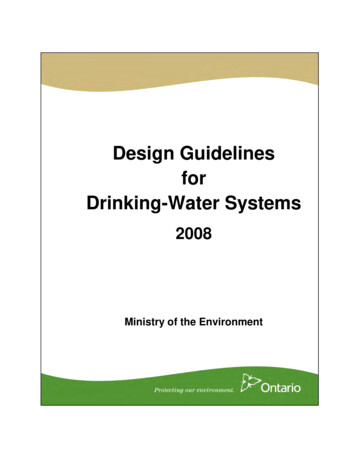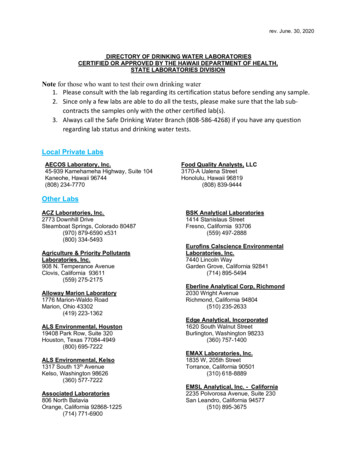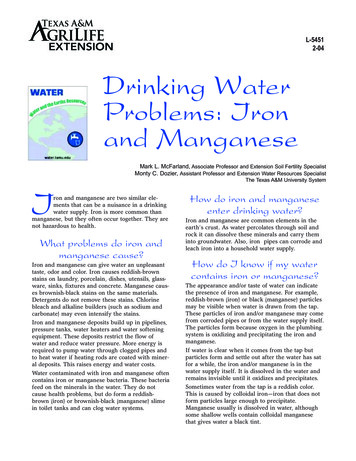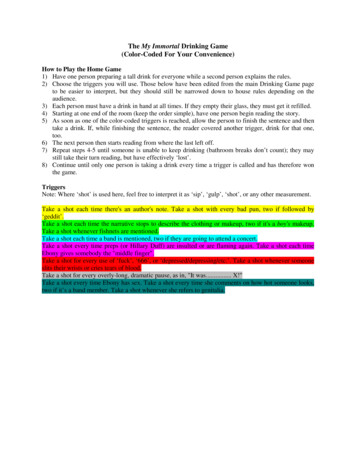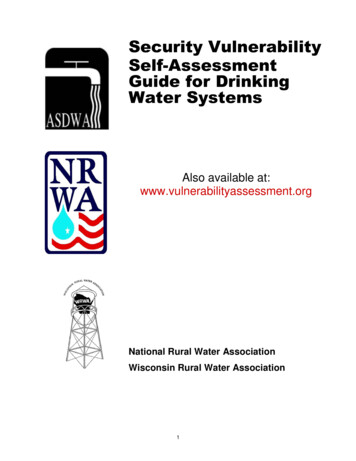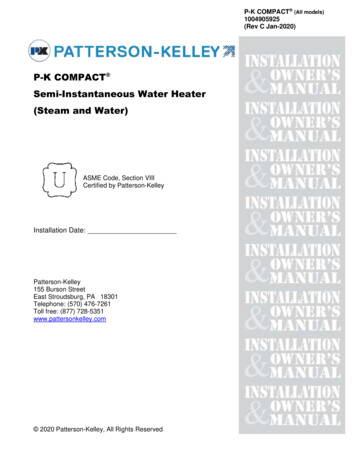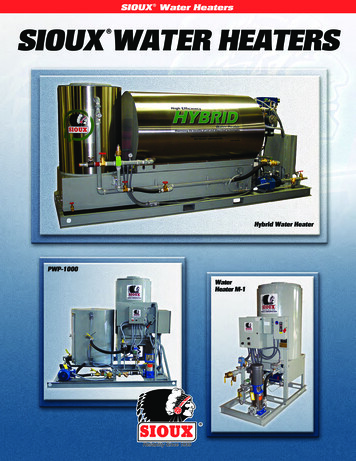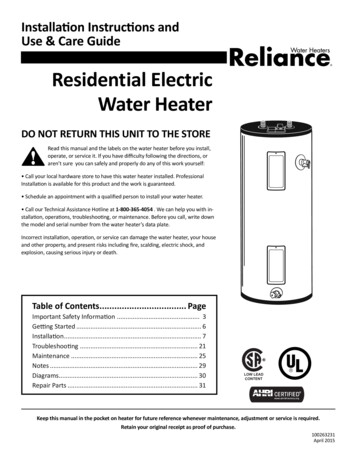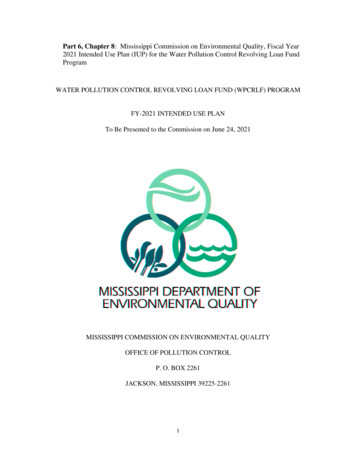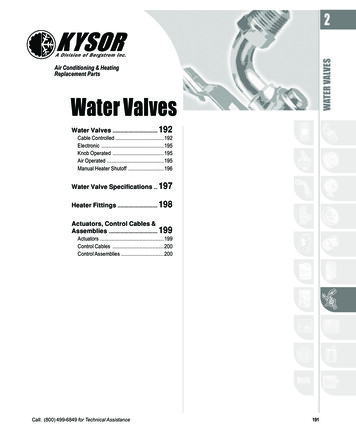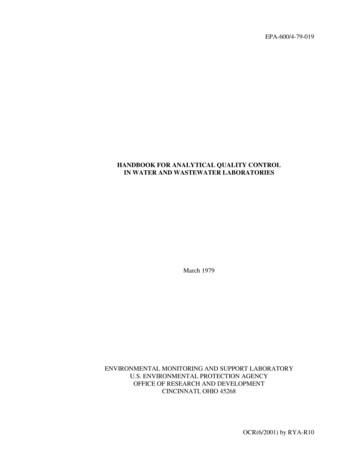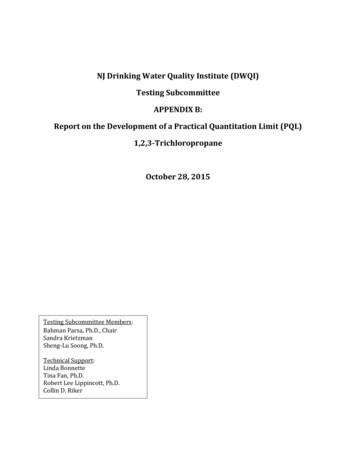
Transcription
NJ Drinking Water Quality Institute (DWQI)Testing SubcommitteeAPPENDIX B:Report on the Development of a Practical Quantitation Limit (PQL)1,2,3-TrichloropropaneOctober 28, 2015Testing Subcommittee Members:Bahman Parsa, Ph.D., ChairSandra KrietzmanSheng-Lu Soong, Ph.D.Technical Support:Linda BonnetteTina Fan, Ph.D.Robert Lee Lippincott, Ph.D.Collin D. Riker
IntroductionIn 2009, the Drinking Water Quality Institute (DWQI) recommended a Practical Quantitation Limit(PQL) to the New Jersey Department of Environmental Protection (NJDEP) for 1,2,3trichloropropane (123TCP) of 0.03 µg/L. The Health-based MCL for 123TCP recommended by theDWQI was 0.0013 µg/L, however, this value was not attainable for quantitation using the USEnvironmental Protection Agency (EPA) approved drinking water method 504.1. EPA method504.1 was the most sensitive analytical method available for analyzing 123TCP at that time. Theanalytical capability was the limiting factor in the MCL recommendation for 123TCP.The PQL of 0.03 µg/L recommended for 123TCP in the “New Jersey Drinking Water QualityInstitute MCL Recommendations for Hazardous Contaminants in Drinking Water (2009)” documentwas reviewed to determine whether this value remains the most appropriate PQL for 123TCP.A review of reporting limits and MDLs for 123TCP in the analysis of New Jersey drinking watercompliance samples submitted since 2009 together with current EPA approved drinking wateranalytical methods and performance data demonstrated that a PQL of 0.03 µg/L is still appropriate.PQL ReviewIn conducting this review, the Testing Subcommittee considered the following: Additional EPA analytical methods not available in 2009, such as EPA 524.3EPA 504.1 data from laboratories analyzing synthetic organic compounds (SOCs)compliance samples for NJ public water systems, since 2009Minimum reporting limits (RL) of laboratories using EPA 504.1 and EPA 524.3Method Detection Limits (MDLs) of laboratories using EPA 504.1 and EPA 524.3Determination of PQL value using median MDL x 5Determination of PQL value using average of minimum reporting limitsDetermination of PQL value using median of minimum reporting limitsBootstrap analysis of MDL and RL dataSince the EPA and the NJDEP have not promulgated an MCL for 123TCP, public water systems arenot required to routinely monitor for this contaminant. However, the National Primary DrinkingWater Regulations (NPDWR) require certain public water systems to monitor for a list of 30regulated SOCs, and through these regulations, the NJDEP has been able to obtain occurrence datafor 123TCP.The NPDWR specify that EPA methods 504.1, EPA 551.1, or EPA 524.3 [40 CFR 141.24(e)(1) andSubpart C Appendix A] are acceptable for two regulated and related SOCs - ethylene dibromide(EDB) and dibromochloropropane (DBCP) – and 123TCP is a target analyte in each of thesemethods.EPA method 524.2 also includes EBD, DBCP and 123TCP as target analytes, however, this methodcannot achieve the published detection limits for EDB and DBCP [40 CFR 141.24(h)(18)]. Therefore,the MDLs and RLs for this method were not considered in 2009 and will not be used in this analysis.2
In NJ, the NJDEP collects samples for SOCs every three years that are analyzed at the NJDOHlaboratory. The NJDEP requires that all analyses of EDB and DBCP using EPA 504.1 include 123TCPas a target analyte. Since EPA 551.1 has not been used in NJ to monitor for EDB, DBCP and 123TCP,this method was not used for PQL development in 2009, and also will not be used in this analysis.If the EPA approves an analytical method to be used for regulatory data, the NJDEP Office of QualityAssurance (OQA) includes that method in their list of Department Sanctioned Analytical Methods(DSAMs). The laboratory must request certification for each parameter within that DSAM in orderto report compliance data for an analyte. An analyte that does not appear in the NJDEP Applicationfor Certification of Environmental Measurements Part III - Analytical Testing Parameters list doesnot mean that New Jersey certification is unavailable for that analyte. If a target analyte analysis isapproved for a method, the laboratory may request certification for that analyte from the NJDEPOQA.There are 15 laboratories certified by NJDEP OQA for 123TCP by EPA 504.1 for drinking watercompliance samples. Only three of these have reported 123TCP data to NJDEP using EPA 504.1.These laboratories analyzed samples for NJDEP, or were contracted by those water systems whichwere required to monitor for EDB or DBCP, or conducted monitoring for water systems withdetections of 123TCP at the request of the NJDEP.Laboratories analyzing EDB and DBPC for compliance purposes must meet the regulatory detectionlimits for EDB and DBCP [40 CFR 141.24(h)(18)]. Since 123TCP is not a regulated contaminant andan MDL cannot be enforced, the NJDEP recommended MDL of 0.005 µg/L is not always met. Somelaboratories have admittedly not tried to generate 123TCP MDLs and RLs as low as possible.The 15 laboratories that are currently certified to report 123TCP drinking water compliance datausing EPA 504.1 were asked for their MDL and their reporting limits. The information appears inTable 1.At the time the 2009 DWQI MCL Recommendation Document was written, the EPA was developingthe EPA 524.3, “Measurement of Purgeable Organic Compounds in Water by Capillary Column GasChromatography/Mass Spectrometry.” EPA 524.3 Version 1.0 was finalized in June 2009. Amongthe list of 76 target analytes are the regulated volatile organic compounds (VOCs) and the SOCsEDB, DBCP and 123TCP. Subsequently the EPA, included method 524.3 version 1.0 in 40 CFR 141Subpart C Appendix A as an additional approved method for the analysis of EDB and DBCP. Theinclusion of EPA 524.3 was made possible under the Expedited Approval of Alternative TestProcedures for the Analysis of Contaminants Rule. Unlike EPA 524.2, the regulatory detectionlimits for EDB and DBCP could be met with EPA 524.3 in Selected Ion Monitoring (SIM) modebecause SIM provides the additional sensitivity needed to reach these detection limits.3
Table 1.MDLs and Reporting Limits from Laboratories Certified by NJ OQA for 123TCPEPA 504.1Lab NameEMSL ANALYTICAL INCCAPE ENVIRONMENTALLABORATORYNEW JERSEY DEPARTMENT OFHEALTHACCUTEST LABORATORIESINTEGRATED ANALYTICALLABORATORIESPRECISION ANALYTICALSERVICES INCBRICK TOWNSHIP MUNICIPALUTILITIES AUTHORITYEUROFINS EATON ANALYTICAL,INCSUMMIT ENVIRONMENTALTECHNOLOGIES, INC.AQUA PENNSYLVANIA INCALS ENVIRONMENTAL MIDDLETOWNEUROFINS LANCASTER LABSENVIRONMENTALEUROFINS QC, INC.TESTAMERICA LABORATORIESINC. BURLINGTONEDGE ANALYTICAL INCNJ Lab IDStateMDL(µg/L)ReportingLimit 0.010.02During the development of the 2009 PQL document, EPA 524.3 was a draft, not final, method. InJuly 2010, EPA provided NJDEP with low concentration minimum reporting limits (LCMRLs) for123TCP from four laboratories from which the MRL was derived. The data obtained was generatedusing SIM mode. The LCMRL values provided to the NJDEP at that time were as follows: Lab 1:10.46 ng/L; Lab 2: 34.48 ng/L; Lab 3: 16.63 ng/L; and Lab 4: 25.19 ng/L. The MRL provided to theNJDEP from EPA was 34.81 ng/L. The MRL was developed by the EPA in three steps:“In the first step, 200 Bayesian Bootstrap (BB) LCMRL replicates are calculated foreach laboratory data set. In the second step a predicted distribution of some unknownand yet to be observed laboratory is built from the population of replicate laboratoryLCMRLs using a random effects model. In the third and last step the MRL is taken tobe the upper 95% one-sided confidence interval on the 75th percentile of the predicteddistribution referred to as the 95-75 upper tolerance limit (95-75 UTL). The 75thpercentile was selected to mirror the design of the PQL, which is often established (orverified) as the concentration at which 75% of drinking water laboratories nationwide4
are predicted to be able to meet as a reporting level. As such, the MRL is designed as anational benchmark for laboratory performance.” (LCMRL MRL Fact Sheet Draft7/26/10)Recently, the EPA has been relating the MRL to the PQL (rather than the MDL) because, “the MRLallows for the simultaneous application of precision and accuracy. It reflects improvements inanalytical sensitivity and it more closely approaches the MCLG of 0 thereby providing EPA with anopportunity for meaningful public health risk reduction.”In the Testing Subcommittee’s pursuit to acquire as much up-to-date data as is available forinclusion in the 123TCP PQL determination, the UCMR3 (third round of sampling required underthe Unregulated Contaminant Monitoring Rule) participating laboratories were identified as apotential source of data. The UCMR3 is a national monitoring program administered by the EPAthat requires community water systems (serving 10,000 and over) throughout the country to testtheir drinking water for a specific set of 30 unregulated contaminants every five years. The mostrecent data was collected from 2013-2015. The UCMR3 list includes 123TCP in the List 1Assessment Monitoring part of the required monitoring.The EPA required 524.3 Version 1.0 to be used for the analysis of 123TCP with the UCMR3. TheMRL is 0.03 µg/L and is based on the previously mentioned LCMRLs. However, the units for theUCMR3 MRL for 123TCP were changed from ng/L to µg/L and two significant figures were used forthe LCMRL values from the four laboratories: Lab 1: 0.010 µg/L; Lab 2: 0.034 µg/L; Lab 3: 0.017µg/L; and Lab 4: 0.025 µg/L (page 49 of EPA UCMR3 Laboratory Approval Requirements andInformation Document Version 2.0 January 2012).There are presently two laboratories that have requested and received approval to analyzedrinking water VOCs using EPA 524.3 through the NJDEP OQA. These laboratories have notrequested certification to analyze and report EDB, DBCP or 123TCP using EPA 524.3. The lack ofEPA 524.3 EDB, DBCP and 123TCP drinking water compliance data seems to be primarily due to theSIM mode analysis not being cost-effective at this time. SIM mode requires repetitive scanning of alimited mass-to-charge ratio rather than scanning the full range. The two New Jersey certifiedlaboratories that use EPA 524.3 for VOCs operate in the full scan mode. A laboratory may find thetime needed to run the analysis in SIM mode for specific analytes such as EDB, DBCP or 123TCP isnot cost-effective compared to the cost of running the EPA 504.1 method.Because the EPA has already established EPA 524.3 as a robust and reliable method for the analysisof 123TCP, this method will be taken into consideration with this review of the 123TCP PQL.Six laboratories were selected from the 38 EPA approved UCMR3 laboratories that can report123TCP data (EPA 524.3). These laboratories were selected based on the following additionalcriteria:1) hold NJDEP OQA certification for VOC drinking water analytical methods (EPA 524.2), and5
2) currently submit compliance VOC drinking water analyses for New Jersey public water systems,and3) have analyzed and reported 123TCP UCMR3 data for New Jersey water systems (EPA 524.3).Each of these six labs, which have been vetted by both the EPA for UCMR3 123TCP analysis and theNJDEP OQA for other organic drinking water methods for which they hold certification, were askedto provide their lowest MRL for 123TCP using EPA 524.3.Table 2 lists the six UCMR3 approved laboratories with their MRLs and MDLs performed by EPA524.3 in SIM mode. The MDL study is optional in EPA Method 524.3, therefore not every laboratoryprovided an MDL.Table 2.MDLs and MRLs fromUCMR3 Approved Laboratories & NJOQA Vetted LaboratoriesEPA 0020.005AQUA PENNSYLVANIA INCPA007PANA0.03ALS ENVIRONMENTAL - MIDDLETOWNPA010PA0.0150.03EUROFINS EATON ANALYTICAL, INCIN598IN0.0150.03SUBURBAN TESTINGPA081PANA0.03AMERICAN WATER CENTRAL SERVICE LABSIL547ILNA0.03Lab NameLabNumberEUROFINS EATON ANALYTICAL, INCTable 3 is a compilation of the MDL and RL data from the 15 laboratories in Table 1 that have NewJersey OQA certification for 123TCP by EPA 504.1, and the six laboratories in Table 2 that have OQAcertification for other drinking water organic analytical methods in addition to being approved bythe EPA for 123TCP analysis using 524.3. These data will be used to determine if the PQLrecommendation in the 2009 Recommendation Document remains the most appropriate valuewhen considering more recent information. Table 3 lists the reporting limit and MDL data fromthese 21 laboratories.6
Table 3.MDL and Reporting Limit DataUsed for the Current PQL EvaluationLab NameNJ /L)EUROFINS EATON ANALYTICAL,INCCA008CAEPA 524.3 SIM0.0020.005NEW JERSEY DEPARTMENT OFHEALTH11036NJEPA 504.10.0020.02TESTAMERICA LABORATORIESINC. BURLINGTONVT972VTEPA 504.10.00380.02EUROFINS QC, INC.PA166PAEPA 504.10.00460.0286CAPE ENVIRONMENTALLABORATORY05679NJEPA 504.10.00470.025PRECISION ANALYTICALSERVICES INC15001NJEPA 504.10.0060.0114AQUA PENNSYLVANIA INCPA007PAEPA 504.10.0060.0625EMSL ANALYTICAL INC03036NJEPA 504.10.00620.02INTEGRATED ANALYTICALLABORATORIES14751NJEPA 504.10.0090.0286ALS ENVIRONMENTAL MIDDLETOWNPA010PAEPA 504.10.010.02EDGE ANALYTICAL INCWA013WAEPA 504.10.010.02EUROFINS EATON ANALYTICAL,INCCA008CAEPA 504.10.0110.04EUROFINS LANCASTER LABSENVIRONMENTALPA011PAEPA 504.10.01430.0429ACCUTEST LABORATORIES12129NJEPA 504.10.0150.02ALS ENVIRONMENTAL MIDDLETOWNPA010PAEPA 524.3 SIM0.0150.03EUROFINS EATON ANALYTICAL,INCIN598INEPA 524.3 SIM0.0150.03BRICK TOWNSHIP MUNICIPALUTILITIES AUTHORITY15006NJEPA 504.10.060.25SUMMIT ENVIRONMENTALTECHNOLOGIES, INC.OH006OHEPA 504.10.090.1AQUA PENNSYLVANIA INCPA007PAEPA 524.3 SIMNA0.03SUBURBAN TESTING
cape environmental laboratory 05679 nj 0.0047 0.025 new jersey department of health 11036 nj 0.002 0.02 accutest laboratories 12129 nj 0.015 0.02 integrated analytical laboratories 14751 nj 0.009 0.0286 precision analytical services inc 15001 nj 0.006 0.0114 brick township municipal utilities authority 15006 nj 0.06 0.25 eurofins eaton analytical, inc ca008 ca 0.011 0.04 summit environmental .
